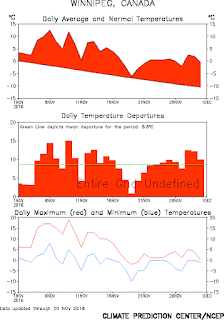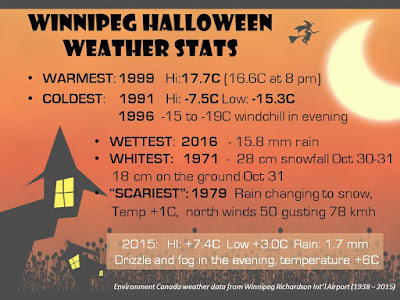 |
Portage Ave buses in downtown Winnipeg - Friday March 4 1966
No one was going anywhere on this day (Free Press photo) |
The winter of 1965-66 was a cold one in southern Manitoba. January 1966 was tied with January 1883 as the
second coldest January on record in Winnipeg, with a bone chilling monthly mean of
-26.7C, some 10C below current January normals. February 1966 saw a brutal cold snap from the 15-20th when temperatures fell to a low of
-45.0C in Winnipeg on the 18th, the
2nd coldest temperature ever recorded in the city since 1872. By the end of February, temperatures were finally starting to warm up with the mercury climbing above the freezing mark on Feb 27th for the first time in almost 3 months. Southern Manitobans were eager to see spring weather finally on its way.
But Mother Nature had different plans..
 |
Surface map - midnight March 2 1966
showing low pressure developing
over Colorado |
On Wednesday
March 2nd, an area of low pressure started to form over Colorado, while a strong upper disturbance was pushing inland from the Pacific. The energy from this impulse would start intensifying this Colorado low and take it northeastward towards the northern US plains. Meanwhile, strong high pressure over Saskatchewan was locking in Arctic air over the Prairies. The battle zone between these two clashing systems was setting up right over the Red River valley and Dakotas.
 |
Surface map - midnight Mar 3 1966
Storm moving over South Dakota |
By the morning of the
March 3rd, the Colorado low storm system had moved into southeast South Dakota and was moving slowly towards southwest Minnesota. The storm system was getting caught by an intensifying upper low which slowed down the progress of the storm. During this time, winds were increasing over the Red River valley, with Winnipeg reporting north winds of 50 gusting to 70 km/h on the 3rd, along with reduced visibilities of 2-5 km in blowing snow. Blizzard conditions were widespread over the Dakotas on the 3rd, and would move into Winnipeg shortly after midnight that night.
Friday March 4th 1966 - The Great Blizzard arrives in southern Manitoba


By the time Winnipeggers awoke Friday morning March 4th, blizzard conditions were widespread across the city and throughout the Red River valley. The pressure gradient between the intensifying storm system over southern Minnesota and the high pressure ridge in Saskatchewan was producing incredibly strong northerly winds through the Red River valley, with
sustained wind speeds of 70-80 km/h in Winnipeg, gusting as high as
113 km/h (70 mph, 61 knots) The combination of the severe winds and heavy snowfall from the storm was producing severe blowing and drifting snow with whiteout conditions across the city and valley. Visibility at Winnipeg airport would drop to
zero by 4 am Friday, and would stay at zero for
14 consecutive hours into the evening. (
Check out this rare CBC video footage showing the whiteout conditions in Winnipeg during the blizzard. Amazing how bad the visibility was even in a built up city.)
 |
March 4 1966 midnight weather map shows storm
over southern Minnesota giving blizzard conditions
over Dakotas moving into southern Manitoba |
 |
Storm system at noon Mar 4 1966
giving blizzard conds over RRV.
Storm is at its peak here with
north winds of 80 km/h gusting
over 100 km/h in Winnipeg |
 |
Even walking became a challenge in the
deep snow and whiteout conditions
(Portage Ave - Winnipeg) |
The slow moving storm system would loop over Minnesota on March 4th, maintaining blizzard conditions over Winnipeg for almost 20 straight hours, and up to 36 hours over portions of the southern Red River valley. The storm dumped
35.6 cm of snow in Winnipeg that day, the second heaviest one day snowfall on record in the city (the greatest one day snowfall of
38.1 cm fell on the exact same date, March 4th, back in 1935) The heavy snowfall combined with storm force winds led to massive drifts in the city, some as high as rooftops of houses. People who ventured to work or stores in the morning were trapped as roads became impassable. City buses were shut down by 11 am as streets became blocked with drifts and stranded vehicles. Hundreds of people were stranded downtown at the Bay and Eatons department stores, which became storm shelters for people for the night until they could find a way home. The city was paralyzed through the weekend into Monday before things could finally get cleared up for the new work week. At least two deaths in the city were blamed on the storm due to heart attacks, and snow removal costs for Winnipeg were upwards of $1 million (1966 dollars), a huge sum back then. Similar scenes were observed throughout the Red River valley and North Dakota, with rural areas immobilized for days by massive drifts left by the blizzard.
30-50 cm of snow fell throughout the Red River valley and southeast Manitoba during the blizzard, with up to
70 cm recorded in Grand Forks from March 2nd to 5th. 50 years later, the Blizzard of 1966 still ranks as one of the most severe blizzards ever to hit Winnipeg and the Red River valley, as well as North Dakota.
 |
Track of 1966 storm shows how system looped over SD and MN
prolonging blizzard over ND and srn MB (from Douglas Ramsey) |
Note: A similarly strong blizzard slammed Winnipeg and southern Manitoba on
Nov 7-8 1986, dumping 35 cm of snow on the city along with 70-90 km/h winds bringing the city to a standstill. Unlike the 1966 blizzard however, the storm occurred late Friday through Saturday, was well forecast, and did not strand as many people as the 1966 blizzard did. Also, the blizzard of
Apr 4-7 1997 was another severe blizzard to hit the Red River valley. That storm was a longer duration event, lasting 3 full days, and dumping a total of
48 cm of snow on Winnipeg along with blizzard conditions for a full 27 hours. That blizzard eventually led to the disastrous "
Flood of the century" that spring over the Red River valley.
 |
Stranded at Eatons: Hundreds of employees and shoppers had
to spend the night at downtown department stores (Mar 4 1966) |
 |
The blizzard left huge drifts across Winnipeg
neighbourhoods, some as high as rooftops |
 |
Sidewalks became snow tunnels
due to the massive drifts |
 |
Portage Ave after the storm - massive snowbanks made
downtown shopping, and parking, a challenge |
BLIZZARD IN THE NEWS
 |
Front page of the Winnipeg Free Press - March 4 1966
proclaims "wild blizzard" as "worst in history" |
 |
Front page of the Winnipeg Free Press - March 5 1966
reporting on storm aftermath and cleanup |
Blizzard of 1966 - by the Numbers (Winnipeg)
- Number of consecutive hours with blizzard conditions: 18 (2 am - 9 pm)
- Number of consecutive hours with zero visibility: 14 (4 am - 7 pm)
- Wind speeds: North 70-80 km/h sustained, with gusts over 100 km/h
- Peak gust: 113 km/h (70 mph, 61 knots)
- Snowfall: 35.6 cm (14 inches)
- Lowest central pressure of storm: 983 mb on the 3rd, 987 mb on the 4th
- Snowdepth: went from 30 cm pre-storm to 66 cm after storm
- Snowdrifts: 1-3 meters
- Fatalities: 2 (heart attacks)
- Cost of clean up: $1 million (1966 dollars)
NOTE: Official
blizzard conditions are defined as a visibility of 400 meters or less and wind speeds of 40 km/h or more, lasting for at least 4 hours
 |
March 4 1966 weather column from
Winnipeg Free Press says it all |

NORTH DAKOTA SNOWFALL TOTALS
Grafton: 32" (81 cm)
Devils Lake: 30.5" (77 cm)
Grand Forks: 27.8" (71 cm)
Jamestown: 27" (69 cm)
Bismarck: 22.4" (57 cm)
Langdon: 20" (51 cm)
Fargo: 15.4" (39 cm)
(graphic: NWS Bismarck)
BLIZZARD LINKS:























































